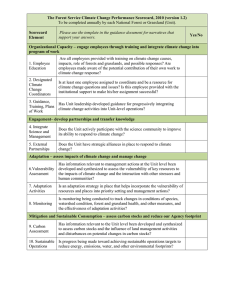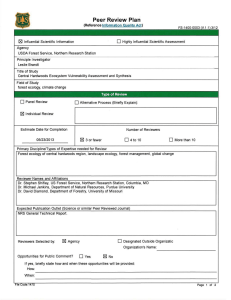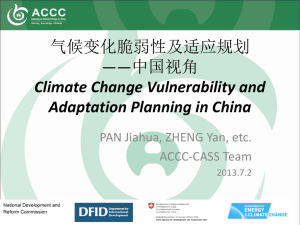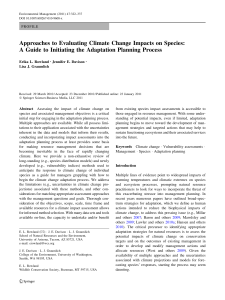Products and Tools to Support Management
advertisement
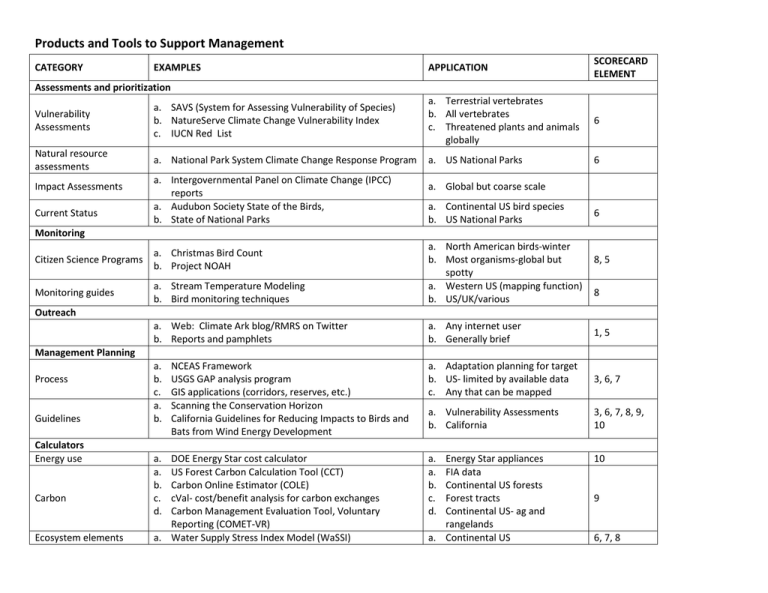
Products and Tools to Support Management APPLICATION SCORECARD ELEMENT Vulnerability Assessments a. SAVS (System for Assessing Vulnerability of Species) b. NatureServe Climate Change Vulnerability Index c. IUCN Red List a. Terrestrial vertebrates b. All vertebrates c. Threatened plants and animals globally 6 Natural resource assessments a. National Park System Climate Change Response Program a. US National Parks 6 CATEGORY EXAMPLES Assessments and prioritization Impact Assessments Current Status a. Intergovernmental Panel on Climate Change (IPCC) reports a. Audubon Society State of the Birds, b. State of National Parks a. Global but coarse scale a. Continental US bird species b. US National Parks 6 Monitoring Citizen Science Programs a. Christmas Bird Count b. Project NOAH Monitoring guides a. Stream Temperature Modeling b. Bird monitoring techniques a. North American birds-winter b. Most organisms-global but spotty a. Western US (mapping function) b. US/UK/various a. Web: Climate Ark blog/RMRS on Twitter b. Reports and pamphlets a. Any internet user b. Generally brief 1, 5 a. b. c. a. b. a. Adaptation planning for target b. US- limited by available data c. Any that can be mapped 3, 6, 7 a. Vulnerability Assessments b. California 3, 6, 7, 8, 9, 10 a. a. b. c. d. 10 8, 5 8 Outreach Management Planning Process Guidelines Calculators Energy use Carbon Ecosystem elements a. a. b. c. d. NCEAS Framework USGS GAP analysis program GIS applications (corridors, reserves, etc.) Scanning the Conservation Horizon California Guidelines for Reducing Impacts to Birds and Bats from Wind Energy Development DOE Energy Star cost calculator US Forest Carbon Calculation Tool (CCT) Carbon Online Estimator (COLE) cVal- cost/benefit analysis for carbon exchanges Carbon Management Evaluation Tool, Voluntary Reporting (COMET-VR) a. Water Supply Stress Index Model (WaSSI) Energy Star appliances FIA data Continental US forests Forest tracts Continental US- ag and rangelands a. Continental US 9 6, 7, 8 References Networks and exchanges a. Southwest Climate Change Network a. Southwest US Clearinghouse a. Climate Change Resource Center a. US Contact lists a. RMRS directory Databases a. Biota Information System of New Mexico (BISON-M) b. Wyoming Natural Diversity Database c. NatureServe Explorer a. a. b. c. Adaptation Options a. Template for Assessing Climate Change Impacts and Management Options (TACCIMO) RMRS New Mexico Wyoming Plants and animals of US and Canada a. Currently mostly Region 8 and 9 1, 4, 5 1, 4, 5, 6, 7, 8, 9, 10 4, 5 6, 7, 8, 9 7 Education a. Science Investi-gator: PNW science journal b. Climate Challenge Game c. Climate Change in the Great Plains webinar a. Elementary school students b. CO2 emissions, not 100% accurate c. Great Plains scientists and managers 1, 5 Projections Climate Projections a. Climate Wizard b. US drought monitor (current conditions & projections) Species Distribution Projections a. Maxent for species distribution modeling b. Climate Change Tree and Bird Atlases Ecosystem Element Projections Collaborations a. Global b. All US a. Species with known distribution b. Eastern US- 134 trees, 147 birds 3, 6, 7, 8 3, 6, 7, 8 a. Reefs at risk a. Coral reefs globally 3, 6, 7, 8 a. Huachuca FireScape a. SE Arizona public and conservation lands 3, 4, 5, 7 a. Native plant nurseries and seed banks b. Drought resistant plant breeding c. Captive breeding facilities a. US-limited coverage b. Agricultural crops c. Few endangered species 7 Other The Forest Service Climate Change Performance Scorecard, 2011 (version 1.3) To be completed annually by each National Forest or Grassland (Unit). Scorecard Element Unit Name Organizational Capacity 1. Employee Education Are all employees provided with training on the basics of climate change, impacts on forests and grasslands, and the Forest Service response? Are resource specialists made aware of the potential contribution of their own work to climate change response? 2. Designated Climate Change Coordinators Is at least one employee assigned to coordinate climate change activities and be a resource for climate change questions and issues? Is this employee provided with the training, time, and resources to make his/her assignment successful? 3. Program Guidance Does the Unit have written guidance for progressively integrating climate change considerations and activities into Unit-level operations? Engagement 4. Science and Management Partnerships Does the Unit actively engage with scientists and scientific organizations to improve its ability to respond to climate change? 5. Other Partnerships Have climate change related considerations and activities been incorporated into existing or new partnerships (other than science partnerships)? Adaptation 6. Assessing Vulnerability Has the Unit engaged in developing relevant information about the vulnerability of key resources, such as human communities and ecosystem elements, to the impacts of climate change? 7. Adaptation Actions Does the Unit conduct management actions that reduce the vulnerability of resources and places to climate change? 8. Monitoring Is monitoring being conducted to track climate change impacts and the effectiveness of adaptation activities? Mitigation and Sustainable Consumption 9. Carbon Assessment and Stewardship Does the Unit have a baseline assessment of carbon stocks and an assessment of the influence of disturbance and management activities on these stocks? Is the Unit integrating carbon stewardship with the management of other benefits being provided by the Unit? 10. Sustainable Operations Is progress being made toward achieving sustainable operations requirements to reduce the environmental footprint of the Agency? Yes/No
